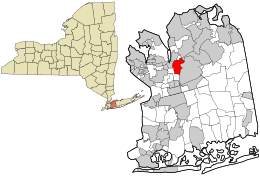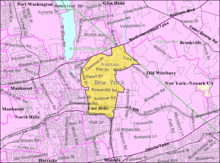East Hills, New York
East Hills is a village in Nassau County, New York on the North Shore of Long Island. It is considered part of the Greater Roslyn area, which is anchored by the Village of Roslyn. As of the United States 2010 Census, the population of the village was 6,955.
East Hills, New York | |
|---|---|
Village | |
| Village of East Hills | |
 Location in Nassau County and the state of New York. | |
 Location within the state of New York | |
| Coordinates: 40°47′39″N 73°37′37″W | |
| Country | United States |
| State | New York |
| County | Nassau |
| Government | |
| • Mayor | Michael R. Koblenz |
| Area | |
| • Total | 2.3 sq mi (5.9 km2) |
| • Land | 2.3 sq mi (5.9 km2) |
| • Water | 0.0 sq mi (0.0 km2) |
| Elevation | 187 ft (57 m) |
| Population (2010) | |
| • Total | 6,955 |
| • Estimate (2018)[1] | 7,189 |
| • Density | 3,000/sq mi (1,200/km2) |
| Time zone | UTC-5 (Eastern (EST)) |
| • Summer (DST) | UTC-4 (EDT) |
| ZIP codes | 11548, 11576, 11577 |
| Area code(s) | 516 |
| FIPS code | 36-22260 |
| GNIS feature ID | 0949124 |
| Website | www |
The Village of East Hills is located in the Town of North Hempstead, spare for a small section of the village's northeast corner, which is in the Town of Oyster Bay.
History
A Historic Overview
The Village of East Hills was incorporated on June 24, 1931, and its first election was held a couple weeks later on July 8.[2]
However, the area now occupied by the village has played a role in the history of both Long Island and the country, as a whole, long before then.[2] In 1643, John Carman and Robert Fordham sailed across the Long Island Sound from Stamford, Connecticut and purchased the land that is now occupied by the towns of Hempstead and North Hempstead from the Marsappeaque, Matinecock, Mericock, and Rockoway Native Americans.[2]
The legacy of the Native Americans in what is now East Hills lives on to this very day. Harbor Hill Road, which was once a Native American trade route, is the oldest road in the village, and is one of the more important roads in East Hills.[2]
Landmarks
George Washington's diary mentions making a visit to Oyster Bay, and of his breakfast at what was previously the George Washington Manor (now Hendrick's Tavern). The paper mill in Roslyn park was inspected by George Washington.
The one thing in East Hills which has been in existence longer than any other man-made object is Harbor Hill Road in East Hills. The road is found in records going back as far as 1661, as "A path alongside Harboure Hill".
For a long time, much of what now is East Hills was home to a few wealthy families. The current neighborhood of Fairfield Park, located across from Roslyn High School on Round Hill Road, was once a polo field. The Country Estates neighborhood was formerly home to Clarence Mackay, Katherine Mackay, and their family for 30 years, beginning in 1898. Their estate was called Harbor Hill (named after the hill of the same name that it sat on). In 1924, the Prince of Wales, who later abdicated the throne of England to marry Mrs. Simpson, was entertained at the Mackay estate. Aviation pioneer Charles A. Lindbergh even rested at the Mackay estate in 1927 after returning to the United States following his historic solo flight to Paris, France. Despite the fact that the Stanford White-designed mansion was sadly demolished prior to the construction of Country Estates, three remaining buildings from the former Harbor Hill estate thankfully still stand, and were listed on the National Register of Historic Places in 1991:[3] Mackay Estate Dairyman's Cottage, Mackay Estate Gate Lodge, and Mackay Estate Water Tower.
Government
On June 24, 1931, representatives of the 269 people residing in the future village met inside the home of Robert H. Willets. The Willets family had resided in the area for eight generations. At the time, the Willets family lived in the house where Stephen Taber lived in 1839. That house, which is still standing, is located at 50 Andover Road, off of the Long Island Expressway's South Service Road near the entrance to the Norgate neighborhood. The name of "East Hills" was adopted after then-Nassau County Attorney, H. Stewart McKnight, recommended it.
Two weeks after the village was incorporated, an election was held in barns on the Mackay estate, and Mr. Willets was elected as the Village Mayor. John Mackay, Stephen Willets, Ellen A. Hennessy, and Catherine Hechler were elected as the Village Trustees. Charles Hechler, the husband of Mrs. Heckler, was designated as the Village Clerk.
Robert Willets served as Mayor until his retirement in 1945. William W. Murray, Jr. succeeded him, he resigned for health reasons in 1952. Murray was succeeded by Raymond E. Dolar. Dolar served as mayor until 1966, when he moved to Florida. In 1967, William R. Fleischer succeeded him, becoming East Hills' fourth Mayor.
The Park at East Hills
On Labor Day 2006, The Park at East Hills opened on the land previously occupied by the Roslyn Air National Guard base.[4] It has a pool, nature walks, senior facilities, and tennis and basketball courts. The construction of the park was financed through the sale of bonds; carrying and operating costs are paid through taxes.
Geography

East Hills is located at 40°47′39″N 73°37′37″W (40.794052, -73.627051).[5]
According to the United States Census Bureau, the village has a total area of 2.3 square miles (6.0 km2), all of it land.
The portions of the village on Harbor Hill, in Clarence Mackay's former estate, are among the highest areas in Nassau County and Long Island, as a whole.
Additionally, the Harbor Hill Morraine is named for this hill, as it is one of the terminal moraine's most prominent and famous topographic features.[6]
Demographics
| Historical population | |||
|---|---|---|---|
| Census | Pop. | %± | |
| 1940 | 343 | — | |
| 1950 | 2,547 | 642.6% | |
| 1960 | 7,184 | 182.1% | |
| 1970 | 8,624 | 20.0% | |
| 1980 | 7,160 | −17.0% | |
| 1990 | 6,746 | −5.8% | |
| 2000 | 6,842 | 1.4% | |
| 2010 | 6,955 | 1.7% | |
| Est. 2018 | 7,189 | [7] | 3.4% |
| U.S. Decennial Census[8] | |||
As of the census[9] of 2000, there were 6,842 people, 2,245 households, and 2,029 families residing in the village. The population density was 2,991.5 people per square mile (1,153.6/km²). There were 2,275 housing units at an average density of 994.7 per square mile (383.6/km²). The racial makeup of the village was 92.94% White, 0.8% African American, 0.01% Native American, 4.82% Asian, 0.01% Pacific Islander, 0.57% from other races, and 0.83% from two or more races. Hispanic or Latino of any race were 1.48% of the population.
There were 2,245 households out of which 46.2% had children under the age of 18 living with them, 84.4% were married couples living together, 4.9% had a female householder with no husband present, and 9.6% were non-families. 8.5% of all households were made up of individuals and 5.4% had someone living alone who was 65 years of age or older. The average household size was 3.04 and the average family size was 3.2.
In the village, the population was spread out with 29.9% under the age of 18, 3.9% from 18 to 24, 23.2% from 25 to 44, 28.6% from 45 to 64, and 14.4% who were 65 years of age or older. The median age was 41 years. For every 100 females, there were 97.1 males. For every 100 females age 18 and over, there were 92.6 males.
The median income for a household in the village was $149,726, and the median income for a family was $159,316. Males had a median income of $100,000 versus $52,115 for females. The per capita income for the village was $59,297. About 1.5% of families and 1.6% of the population were below the poverty line, including 1.1% of those under age 18 and 3.0% of those age 65 or over.
Politics
In the 2008 presidential election, Democrat Barack Obama won East Hills over Republican John McCain 54%-46%.
East Hills, a part of the Town of North Hempstead, is represented on the Town Board by one of its former trustees, resident Peter J. Zuckerman.[10] Zuckerman was sworn into office by East Hills Mayor, Michael Koblenz.
As of April 2020, the Village of East Hills is represented in the Nassau County Legislature by Legislator Joshua Alexander Lafazan.[11]
References
- https://www.census.gov/quickfacts/fact/table/easthillsvillagenewyork/PST045218
- "Village of East Hills History". villageofeasthills.org. Retrieved October 7, 2017.
- "National Register Information System". National Register of Historic Places. National Park Service. March 13, 2009.
- "Park History | Village of East Hills". villageofeasthills.org. Retrieved 2020-04-24.
- "US Gazetteer files: 2010, 2000, and 1990". United States Census Bureau. 2011-02-12. Retrieved 2011-04-23.
- "Garvies Point Museum and Preserve - Geology of Long Island". www.garviespointmuseum.com. Retrieved 2020-05-15.
- https://www.census.gov/quickfacts/fact/table/easthillsvillagenewyork/PST045218
- "Census of Population and Housing". Census.gov. Retrieved June 4, 2015.
- "U.S. Census website". United States Census Bureau. Retrieved 2008-01-31.
- "Town of North Hempstead - Councilman Peter J. Zuckerman (2nd District)". www.northhempsteadny.gov. Retrieved 2020-04-24.
- "District 18 - Joshua A. Lafazan | Nassau County, NY - Official Website". www.nassaucountyny.gov. Retrieved 2020-04-24.